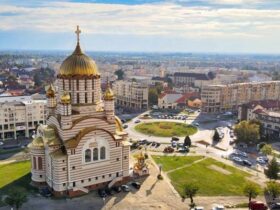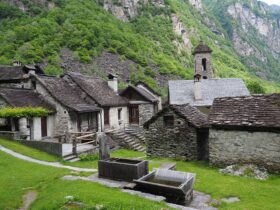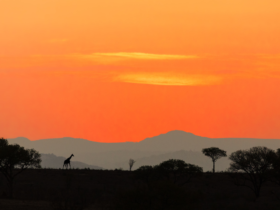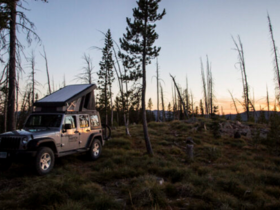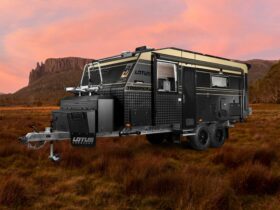The experience on the trek to Mera Peak was a surreal one. Everything was buzzing as I walked through the vibrant streets of Kathmandu. I was setting off on an expedition that would lead me high into the Himalayas, challenge my body and mind, and if all went well, see me atop 6,476-metre Mera Peak. Little did I know that this climb would be a personal challenge not only of strength but one of self-discovery.
My adventure started out with an exciting flight from Kathmandu to Lukla! The journey there was an experience in itself — little planes weaving through enormous mountains to land on one of the world’s most difficult runways. After touching down in Lukla, we set off to walk toward Mera Peak Base Camp. The route traversed thick forests, crossed fast-moving rivers, and skirted charming Sherpa villages, each with its own traditions. The serenity of the atmosphere was spellbinding and my heart thrilled with wonder at the distant Himalayas ochre peaks rising from afar.
But the hike to Base Camp wasn’t without challenges. It was a dreadful grind uphill, and the thin mountain air was a bummer. In the process, I became hyper-alert to the significance of acclimatization. We took regular rest days, giving our bodies some time to acclimatize to the elevation. The intermediate stops allowed me to think, adjust and, above all, relish in the dazzling nature and incredible Sherpa culture around us. Even though I was only there for a short time, I found myself humbled by the warmth and kindness of the locals — people who lived in one of the remote parts of the world yet had so much quiet strength and resilience.
Reaching Base Camp was a big deal. It would be thinner, and colder too, but the adrenaline rush of having made it so high up was huge. The surrounding beauty — jagged peaks, glaciers, the vast, silent expanse of snow — was inspiring. But I knew the far greater challenge was then to come. A few days off with some resting and preparations followed before it was time to ascend to High Camp, placed at approximately 5,800 meters.
The climb from Base Camp to High Camp was a grueling one. The higher we climbed, the thinner the air got, making each step a goliath jump. The ground was rougher, too, covered as it was with snow and ice, and the trail wound its way through fields of rocks.” The weather could turn at a moment’s notice, and I had to keep my head on straight. It was physically hard, and whilst still no doubt about it, everyone’s hardship was worth in nature’s surroundings.
After a night at High Camp came summit day. We started our ascent at about 3 a.m., the air sharp and frigid as we stepped into the darkness. My body grew heavier with every step, but that thought kept me going. The last part was by far the hardest — an exhausting mix of ice and snow and rock. But what we were accosted with as we approached the summit was nothing short of spectacular. Mera Peak (6476)At the summit of Mera Peak, I had a sensation of victory. The panorama of Everest, Makalu, and Cho Oyu was beyond what I could have imagined. Time froze, and I understood how much I had transformed on this trip.
It was a long descent but gave me time to reflect on the experience as a whole. The arduous trek to Base Camp, the difficult process of acclimatization, and the push to the summit, each aspect of the journey had taught me lessons worth having. Perhaps most importantly, what I discovered was that the real beauty in climbing Mera Peak wasn’t the summit at all, but the personal development and resilience gained in the process. It was a trip that would stick with me for years, and that bonded me to the mountains and their many lessons.
Mera Peak: On the Mountain & in the Mind
Mera Peak base camp The idea of Mera Peak had been watching me for several years. An avid hiker, I was enchanted by the idea of the Himalayas, the tallest mountain range in the world, and the thrill of standing in addition to one of their peaks was too tempting to resist. Standing at 6,476 meters (21,246 feet), Mera Peak is one of the highest trekking peaks in Nepal, combining challenge and adventure for amazing views of famous mountain landmarks including Mount Everest, Makalu, and Lhotse. What tantalized me most about Mera Peak was that it presented a realistic ascent for people with a basic mountaineering capability; an ideal introduction to high-altitude mountaineering. Being on top of the world, with the majestic backdrop of the Himalayas was, I knew, going to change me forever. Mera Peak Summit’s dream turned into a very strong motivating point for me when I took the challenge.
Preparation: Preparing for the Journey
So prep for an expedition to Mera Peak is not to be taken lightly. For months before the climb, I began preparing my body and my mind. I added regular cardiovascular exercise, strength training, and endurance workouts to my schedule, along with as much hiking and walking with a weighted pack as I could manage to replicate the conditions of the trek. Also, I devoted time to learning about basic mountaineering skills, including crampons, ice axes, and ropes, which would be essential for the climb. In the weeks before I went, I remembered to buy everything I needed, ensuring to wear thermal layers, trekking… and special equipment such as a harness and helmet. Another key component of preparation was studying the terrain, the climate , and the altitude. Key to that safe passage was the knowledge we developed about acclimatization and altitude sickness as well. I mentally girded my loins, knowing that this would take a lot more than just the brute strength in my legs — that there would be willpower necessary, patience, and mental stamina in the face of adversity along that climb.
Kathmandu: The Starting Point of a New Adventure
A city of life, color, noise, and temples, had already warmed us up for the great adventure to come. Kathmandu is the jumping-off point for most Himalayan treks, and it’s where I would rendezvous with my guide and fellow climbers. The first day in the city was filled with quiet final supply runs, equipment checks, and soaking in the energy of the city’s hallmark locations. Kathmandu’s richness of ancient and modern was interesting enough, but I knew that the real journey was still to come. The sights and sounds and smells of the city — and there was everything from incense in the temples to the rush of traffic — was a sensory overload, but it also felt like the right way to start. Having slept and prepared the next day, it was finally time to head for the gateway of the mountains: Lukla. On their last day in Kathmandu, I felt the sense of excitement of the adventure yet to come.
Header: Headings: The Gateway to the Himalayas
Mera Peak preparation It is in Lukla that the real adventure begins. Following an exhilarating, scenic airplane ride from Kathmandu to Lukla, the portal to the Himalayas, I arrived at the small, high-altitude airport known for its famously short runway. It was a white-knuckle experience even at the best of times, the plane snaking through narrow mountain passes before touching down on a slope. The jubilation after that step was tangible—this was not a dream anymore, it was actually happening. The air was cool and crisp, and the mountains loomed in the distance, all being shrunk to the sign of the trek. Lukla, which stands at an altitude of 2,860 meters (9,383 feet), is where trekkers usually start their trek to Everest and other legendary peaks. It was here that I was introduced to my fellow trekkers and our team of seasoned Sherpa guides, who would accompany us every step of the way. After a quick tea stop and check-in of our equipment, we were off to the first day of trekking. The trail to come would guide us through dense forests, across rivers, and up through charming villages, but it all started in the small, bustling town of Lukla. That electric feeling of excitement and potential enveloped us when we stepped onto the trail that would take us further into the Himalayas.
Mera Base Camp Trek: A Journey Through The Scenic Wonders
The trek to Mera Peak Base Camp was both physically demanding and beautiful. Beginning in Lukla, we traveled on a heavily traveled route that went through Sherpa towns, thick trees and foothills that showed us the lives of the local population. The beginning part of the hike was unexpectedly verdant, with rhododendron trees pine forest, and colorful, peaceful wildflowers. The air was cool and crisp, and the slope began exposing towering snowcapped peaks in the distance. With each step the landscape changed, getting rougher as we made our way up heat-skewed ascents and stepped over shale-riddled paths. We crossed several suspension bridges and were able to meet locals in the tiny, remote villages along the way. The hike wasn’t easy — there were steep ascents, tricky switchbacks, and a couple of river crossings — but the beauty of the surrounding landscape made every step worthwhile. Each day, we encountered new and more rousing views; the presence of the Himalayan giants, hovering around, made it all the more exhilarating. The hike was a slow, steady slog, giving us time to acclimatize and adjust to the high altitude while taking in the amazing scenery.
Base Camp: Initial impressions and hurdles
Which made it a huge accomplishment to reach Mercury Beach Camp. With a height of 5,300 meters (17,388 feet), the Base Camp is incredibly lofty, and I could instantly feel the difference in the air. The atmosphere at these higher elevations was thinner, making breathing even more difficult and the temperatures were colder than at lower altitudes. The sensation of being at the foot of such an impressive mountain, however, was too much to bear. With glaciated valleys and soaring mountains, the landscape around us was breathtaking and humbling. The Base Camp was nothing more than a small, barren patch of earth, covered in tents and the occasional makeshift shelter. The busy villages and forests far below seemed like another world, and I could feel the enormity of the challenge ahead. The physical tiredness was beginning to be felt, but this ensuing sense of excitement and determination pushed me forth. At this altitude, the benefits of acclimatization were becoming obvious. We spent a few days here to acclimatize our bodies before moving to High Camp. The physical struggles were real, but Base Camp was so beautiful and peaceful that it made everything worthwhile. It was already a life-changing trip, and the summit lay ahead.
Adaptation: Adjusting to the Higher Elevations
Mera Peak itinerary Could you please tell us about the importance of acclimatization to Mera Peak climbing? At Base Camp, located at 5,300 meters, the air has only about 50 percent of the oxygen present at sea level, which can cause altitude sickness if correct acclimatization procedures aren’t observed. To acclimatize our bodies, we stayed several days at Base Camp, taking short hikes to higher elevations and then returning to Base Camp to sleep. This practice — known as “climb high, sleep low” — enables the body to adapt through increased production of red blood cells, allowing better delivery of oxygen. We spent that time working to keep hydrated, eating properly, and sleeping in order to prevent exhaustion. The need for acclimatization became evident as I started to feel the effects of gaining altitude: breathlessness, headaches, mild dizziness — these became my constant companions. But through taking it slow, being aware of our bodies, and listening to our guides we averted the more serious symptoms of altitude sickness. When we transitioned to High Camp, our bodies had adjusted enough to tackle the summit push with more confidence.
The Road Gets Tough: Climbing to High Camp
One of the hardest sections of the Mera Peak expedition was the trek to High Camp. High Camp, at 5,800 meters, is a much more exposed and barren landscape. Base Camp to High Camp: The climb from Base Camp to High Camp consists of a mixture of rocky moraine, ice fields, and snow. The air grew thinner with every step, and the cold became penetrating, though that was only as we got higher. It was a long and grueling drive through some of the more rocky roads. It was a steep climb that required a lot of effort and by the time we got to High Camp, I was feeling tired and needed rest. But a summit lay ahead, and that gave me purpose. The small cluster of tents at High Camp looked like a welcome refuge from the brutal elements. We camped over night there to ready ourselves for the final push. Altitude was beginning to hit me harder, and it was obvious that the summit push tomorrow would take not just physical endurance but also mental endurance to fight through the difficulties of the high-altitude environment.
Day 5: To the Summit: The Last Push to the Top
By the time dawn broke summit day, we were already up and about. The plan was to leave around two in the morning, to minimize the wind and take advantage of cooler conditions before the afternoon winds started to pick up. The air was thin, each breath an effort, but the high of the summit push helped block out the discomfort. We climbed slowly and deliberately, using headlamps to navigate the snow and ice fields. The last bit up top was melting steep ice slopes and more technical bits. The views were breathtaking, as was the thought of finally getting to the top, but as each minute ticked by, my legs burned like hot acid. Hours of climbing later the first pickings of light were spilling over the horizon, warming the snow-draped peaks. And then finally, we were at the top. It was the indescribable feeling of elation, exhaustion, and awe all at once, standing at the top of Mera Peak. The view of the Himalayas in all their glory—Everest, Makalu, Cho Oyu , and so many others—was breathtaking. The absolute scale of this landscape and the immense work to reach it made it feel very rewarding at the moment.
The Road Paved: Track-Record of Trials
Climbing Mera Peak had its challenges too. In addition to the physical demands of the ascent, one of the biggest challenges was the fickle nature of the weather. It was frosty, particularly high, and high camp, I hardly got sleep because of the freezing winds. The thin air, combined with the constant effort to catch my breath, also sapped my energy. On occasion, a few reservations sneaked in, particularly when exhaustion and altitude sickness symptoms started to take over. The physical strain of climbing the mountain was not the only challenge on summit day; mental discipline to overcome extreme discomfort was needed. The cold, the steepness, and the constant height had made each step feel like a war zone. But with each step, the summit closed, with the rewards for perseverance grew closer. This together with the unwavering guidance of our guides and fellow climbers helped to pull through these challenges. They were there to lend words of encouragement, share their stories, and remind us that we were capable of grinding through the darkest of hours.
Confessions from the Top: A time of triumph
Standing on top of Mera Peak permit was a moment of absolute victory. I had stood atop numerous summits, head back, eyes closed, soaking in the moment. In the distance loomed Mount Everest, Makalu, Lhotse, and the other giants of the Himalayas, their jagged profiles etched against the blue sky. The summit view was unlike any I had ever seen before, a fitting reward for the physical effort and mental fortitude required to reach it. I melted all the fatigue, doubts, and struggles away. It was one of those moments where I felt on top of the world, awash in the magnificence of the landscape all around me, somehow larger than life but, at the same time, small and humbled by the scene. It felt incredibly rewarding; it was the payoff for months of preparation, the payoff for everything that was difficult every step of the way. It was a moment where I understood that the summit was more than just standing on top of the mountain — it was the journey, and what it took to get there.
Reflections: Learning and the Return Home
Mera Peak climbing safety Descending from the peak was a long process and, as we returned, I thought about some lessons I learned from this climb. Mera Peak had stretched my boundaries in ways I could not have anticipated. It reminded me to be patient, persistent, and how crucial acclimatization was, and, stepping back a bit, listening to my body. The expedition taught me the power of teamwork and camaraderie. We had the encouragement, knowledge and support from our Sherpa guides and fellow climbers in this expedition. On the whole, though, it was an experience that left me with a greater respect for the mountains and the people who live in them. As I made my way back to Kathmandu, tired yet exhilarated, I realized not only that climbing Mera Peak wasn’t about the summit, but that surpassing those challenges and discovering the beauty of the journey had transformed me. How cool it was to complete a thing!


